This is our step-by-step guide on how to dehydrate beef stock for a homemade beef bouillon. Dehydrating beef stock in your food dehydrator is easy to do. Dehydrated beef stock bouillon is perfect for taking dehydrated camping and backpacking meals to the next level with more flavor and fewer artificial ingredients.
We are going to dehydrate good quality store-bought, no-sodium beef stock to make a powdered beef bouillon. If you look at store-bought beef bouillon ingredients, you would be shocked at how little actual beef broth and how many gibberish ingredients are included on the nutrition label.
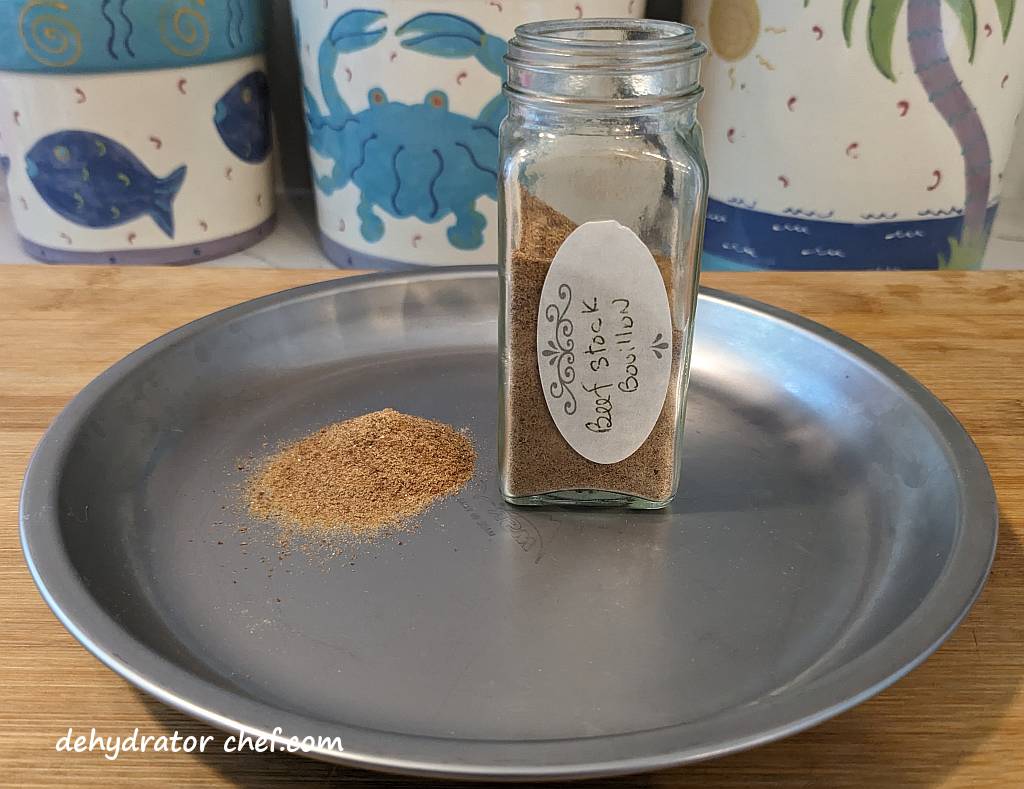
One of the reasons we dehydrate is to avoid these types of additives in our dehydrated meals, DIY MREs, and everyday pantry essentials.
We aren’t really focusing on food additives. But this is disturbing. A random look at the store shelf offerings of beef bouillon includes a somewhat disturbing menagerie of ingredients. On your next trip to stock up on food items, take the time to look, then consider our how-to guide.
Save those gelatin versus collagen and bone broth questions for another time. We didn’t have the time or materials to make a beef bone broth. So, we’re adding the “gel” back to the store-bought beef stock using gelatin. A real homemade bone broth will have copious amounts of collagen.
So, let’s get started dehydrating beef stock to make bouillon.
Table of Contents
- How to Dehydrate Beef Broth
- Supplies Needed for Dehydrating Beef Broth
- Ingredients Needed for Dehydrating Beef Broth
- Step 1. The Process for Dehydrating Beef Stock
- Step 2. Preparing for Dehydrator for Dehydrating Beef Stock
- Step 3. Dehydrating Beef Stock
- Step 4. When is the Dehydrated Beef Stock Done
- Step 5. Equalizing and Conditioning of Dehydrated Beef Stock
- Step 6. Storing the Dehydrated Beef Stock
- Weights, Measures, and Serving Sizes
- Insider Tips
How to Dehydrate Beef Broth
It’s easy to dehydrate beef broth and make beef bouillon. All you need to dehydrate beef broth is a good-quality food dehydrator. We use the Nesco food dehydrators. You can check out our food dehydrator guide to learn why we think Nesco offers the best bang for the buck. We believe this is the best food dehydrator for our long-term food storage needs.
Supplies Needed for Dehydrating Beef Broth
- Food dehydrator
- Removable fruit roll sheet inserts for the dehydrator trays
- Wide-mouth canning jar funnel
- Spice grinder
- Spice jar funnel
- Spice jars
- Pastry dough scraper
- 10 x 16-inch sheet pan
Ingredients Needed for Dehydrating Beef Broth
- 1 32-ounce or 1-quart carton of no-sodium beef stock
- 4 packets of unflavored gelatin
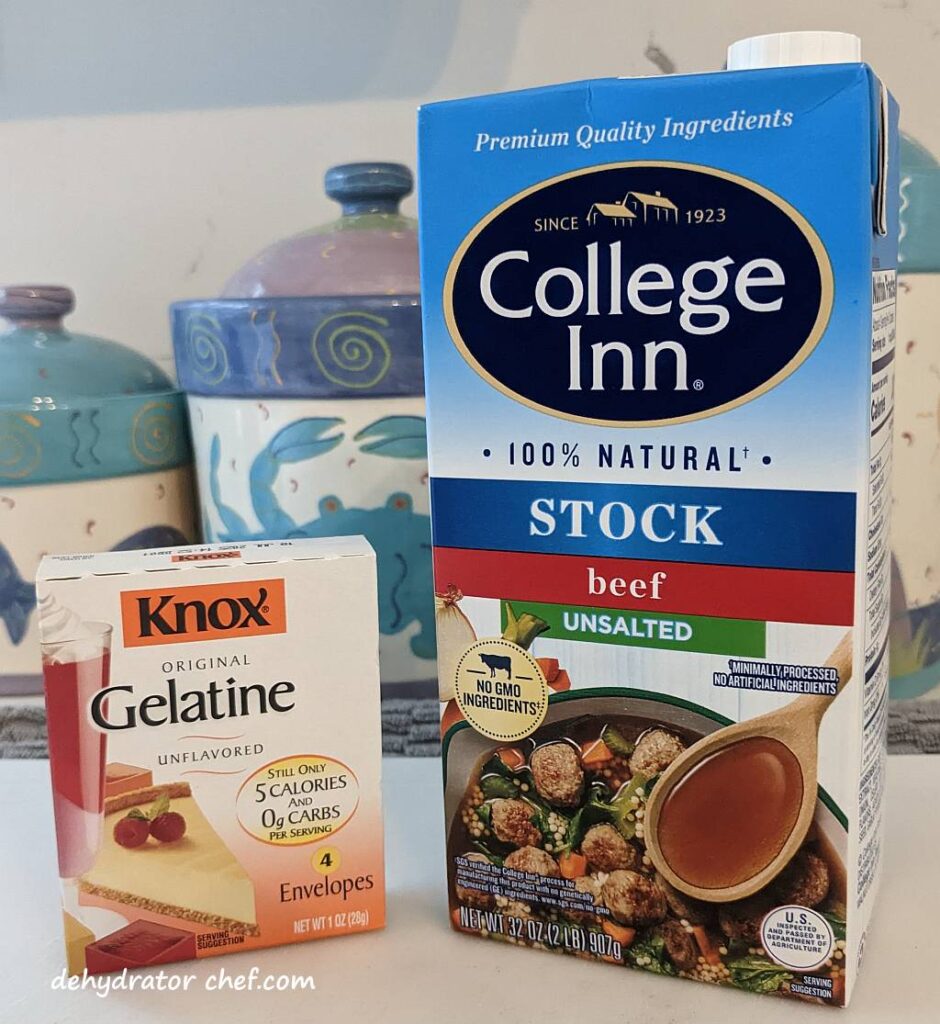
Step 1. The Process for Dehydrating Beef Stock
What we are making first is beef stock gelatin. For every 32-ounce container of no-sodium beef stock, you’ll need 4 envelopes of the Knox unflavored gelatin. The Knox unflavored gelatin box says to use 1 envelope for every 8 ounces of liquid.
Prepare according to the directions for the unflavored gelatin package. This is how I prep for making dehydrated beef stock.
Bring 3 cups of beef stock to a boil in a saucepan.
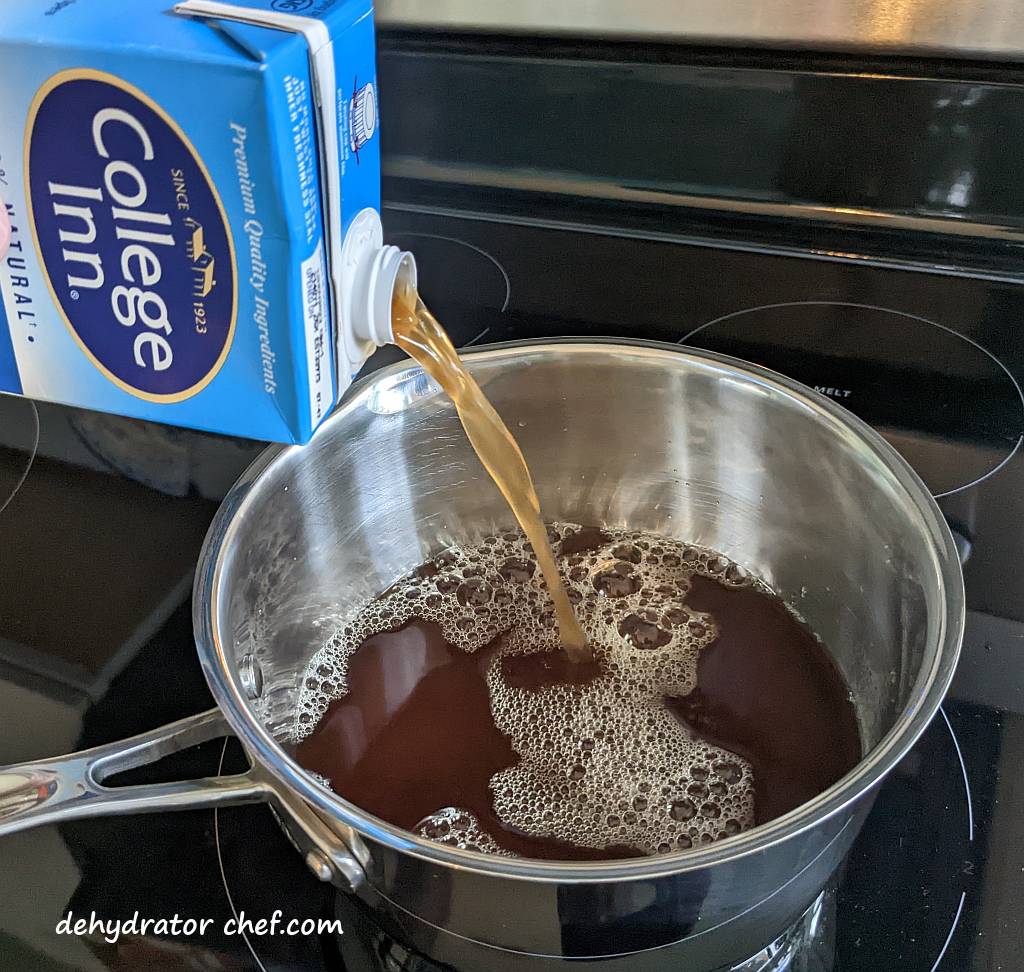
Meanwhile, sprinkle the contents of the 4 envelopes of gelatin over the remaining beef broth in a large bowl; let stand for 1 minute.
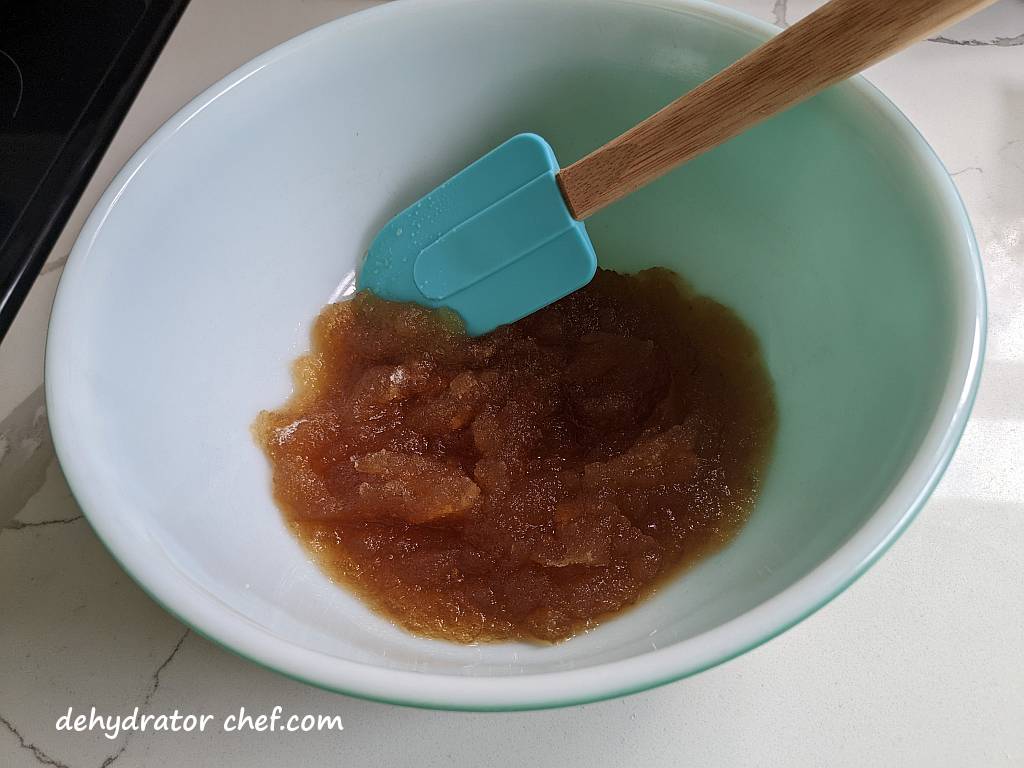
Add the hot beef broth into the large bowl of softened gelatin; stir for 5 minutes or until completely dissolved.
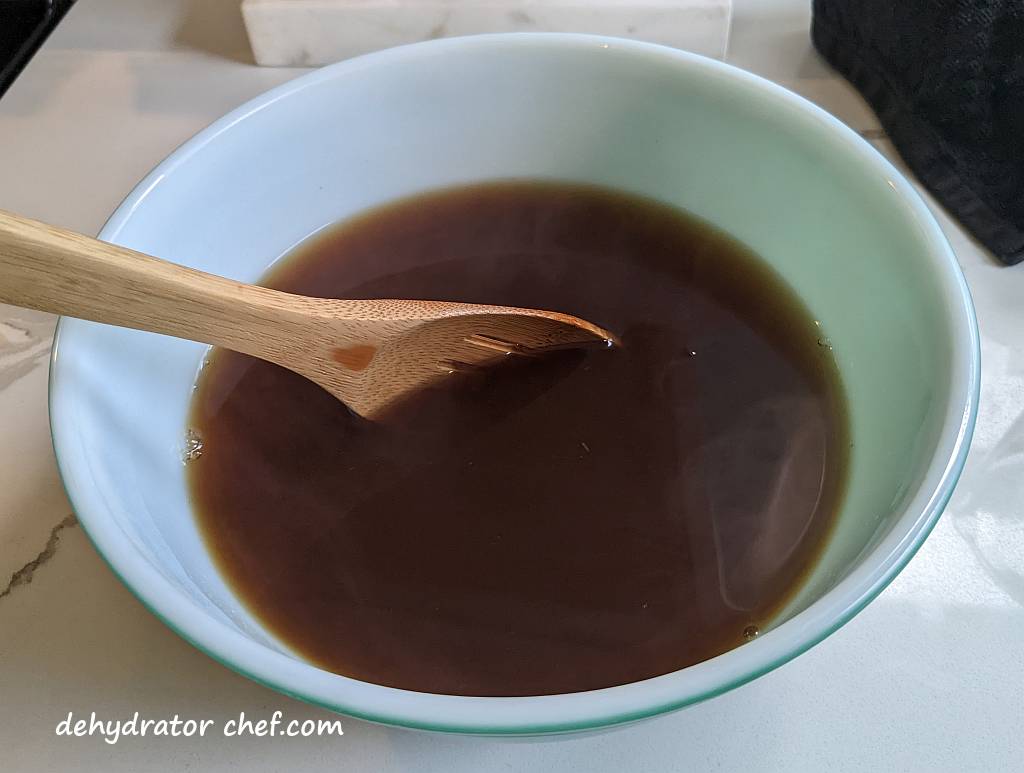
Pour the liquid onto a 10×16-inch or similar-sized baking sheet. You don’t want the liquid to be too thick.
Refrigerate for 3 hours or until firm.

Cut into 1- to 2-inch squares using a pastry dough scraper, small stainless-steel spatula, or similar kitchen tool. A pastry dough scraper also makes it easy to get the beef stock gelatin squares off the baking sheet and onto the dehydrator tray removable fruit roll sheet inserts.
Step 2. Preparing for Dehydrator for Dehydrating Beef Stock
First things first. Make sure your food dehydrator sits level. The beef stock gelatin squares will melt back into a liquid as the dehydrator comes up to temperature.
It is much easier to work with gelatin squares versus handling liquid stock on the dehydrator trays. With gelatin squares, there is no need to balance liquid-filled dehydrator trays as we get them set up. And no messy spills to clean up.
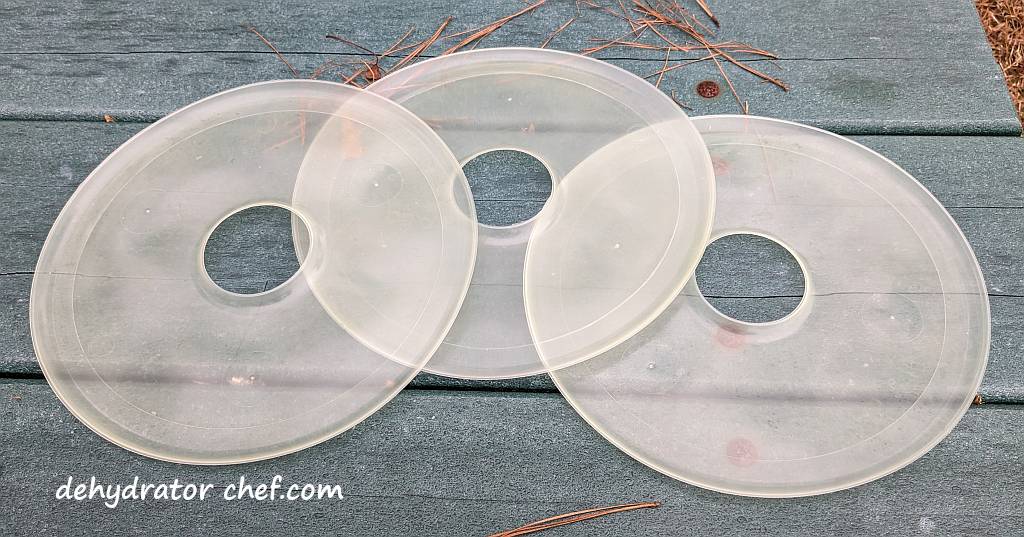
We will use these removable Nesco fruit roll sheet inserts on our Nesco FD-61 for the dehydrating beef stock project. They have over 3000 customer reviews with an average rating of 4.5 stars out of 5, which is evidence of a great product. Check out other Nesco food dehydrator products here.

Evenly spread out the beef stock gelatin squares onto the removable fruit roll sheet inserts for even drying. If it’s too crowded, prepare another dehydrator tray. You don’t want the squares to melt and overflow the fruit roll sheets.
The Nesco FD-61 removable fruit roll sheet inserts will hold a bit more than 2 cups of liquid sitting level because of their “No-Spill Lip” feature for drying sauces, soups, and other liquids.
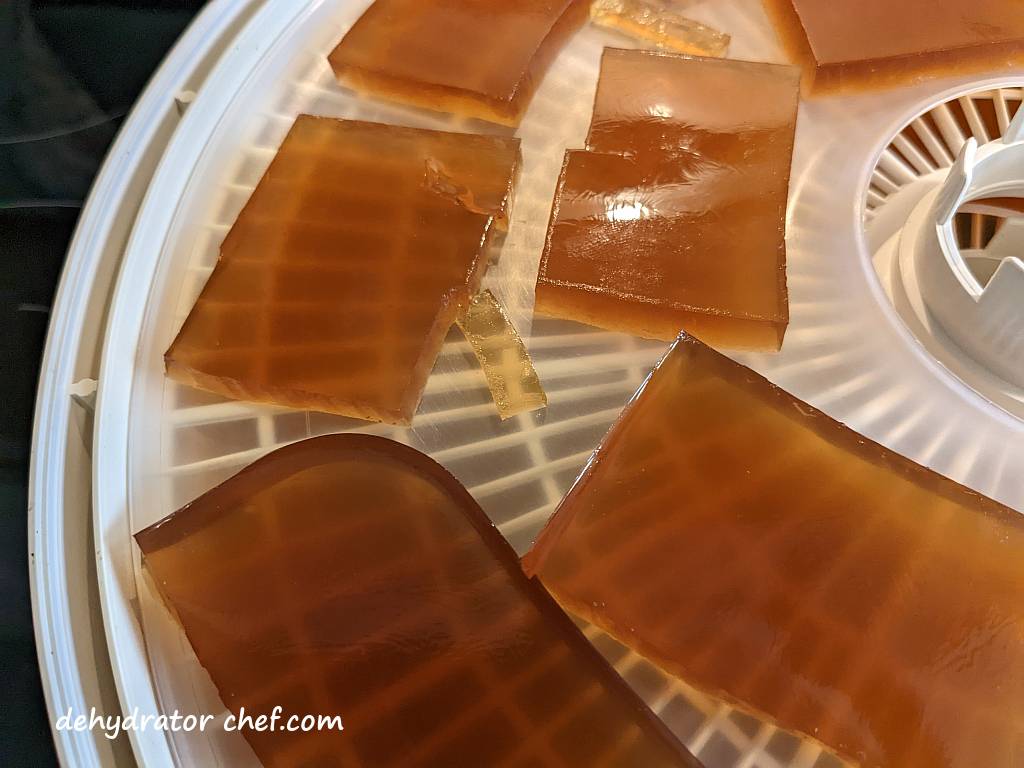
The Nesco FD-61 food dehydrator tray has close to 119 square inches or .8 square feet of surface area for drying.
Step 3. Dehydrating Beef Stock
Start dehydrating the beef stock gelatin at a drying temperature of 160 °F / 71 °C until dry, approximately 24 hours, depending upon the ambient temperature and humidity and how crowded you fill your trays. Remember to use drying times as a guide.
Step 4. When is the Dehydrated Beef Stock Done
The beef stock will take 24 hours to fully dehydrate at 160 °F / 71 °C depending on ambient temperatures and humidity.

Drying times will vary depending on your dehydrator. Refer to your dehydrator owner’s manual for recommended temperatures and times for dehydrating specific foods. Remember to use drying times as a guide.

When the beef stock has fully dried, it will easily snap into little pieces. There should be no tacky spots.
Step 5. Equalizing and Conditioning of Dehydrated Beef Stock
We always recommend letting food items cool completely after they have finished dehydrating and before packing them into an airtight storage container for equalizing and conditioning. Warm food may cause sweating, which could provide enough moisture for mold to grow.
It does not take long for dehydrated food items to start hydrating from ambient household humidity. Do not leave dehydrated food items exposed to the elements any longer than necessary because of the increased risk of mold growth.
Break apart the larger pieces of dehydrated beef stock into smaller shards. The thicker areas of the dried beef stock remind me of making sugar glass and how easily it breaks.
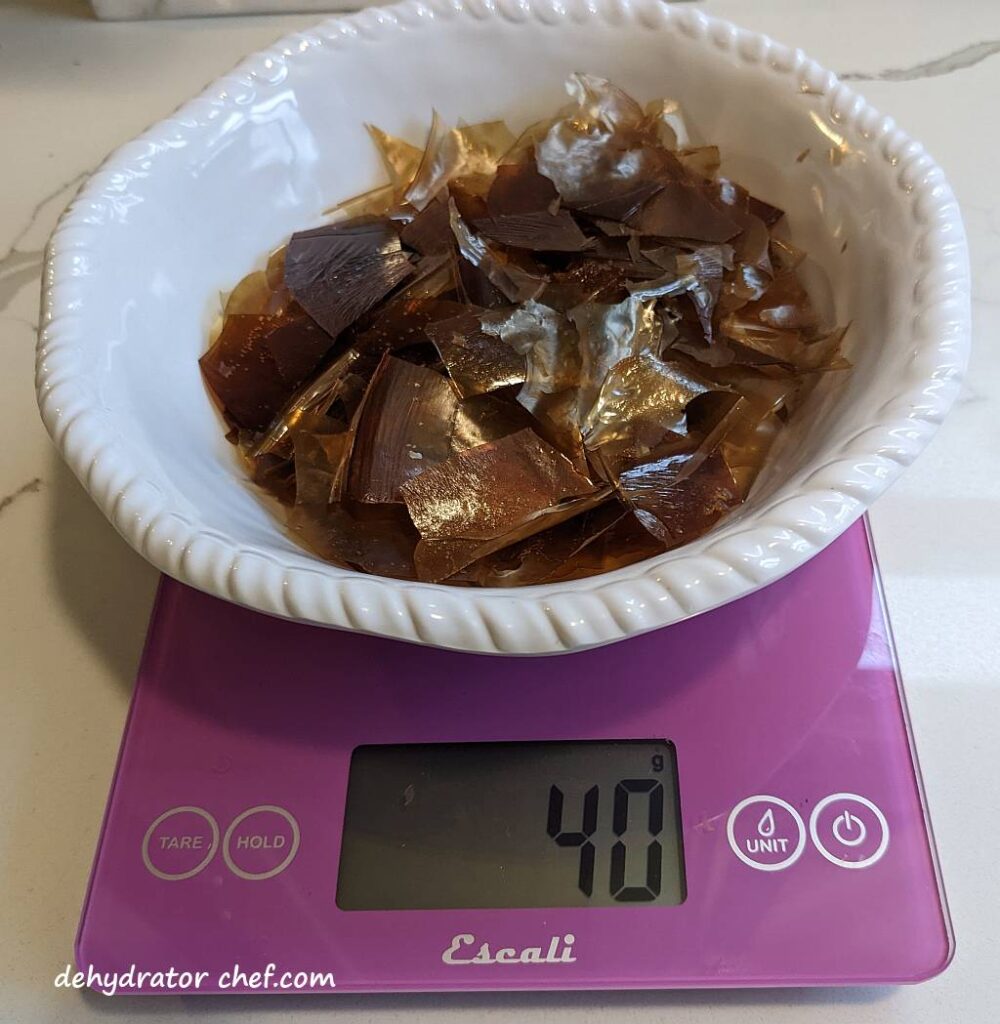
A quality stainless steel or plastic canning jar funnel makes the messy job of getting dehydrated foods off the dehydrator tray removable inserts and into the canning jars an easy task. Take a minute or two and check them out here on Amazon.
After a short cooling period, pack the dehydrated beef stock shards into a clean, dry, insect-proof, and air-tight storage container. We use pint-size and quart-size canning jars for conditioning. Since the canning jars are clear, it’s easy to see what’s inside.
When the dehydrated food is removed from the dehydrator, the remaining moisture may not be distributed equally because of its location and position in the dehydrator. Equalizing and conditioning is a process for freshly dehydrated foods that ensures any residual moisture remaining in any piece is spread or equalized among all the other pieces in the batch. Let the dehydrated food equalize and condition in the storage container for 7 to 10 days.
Every day, check the jar for moisture. Roll the jar contents around and note any clumping or sticking. If seen, put the contents back on the dehydrator for several more hours. Since canning jars are clear, it’s easy to see what’s inside.
If you notice any mold at all, even the smallest bit, throw it all out. What you see are the mold spores finally blooming enough to make them visible. But there are more, even tinier mold spores in the rest of your jar that make your dehydrated food inedible. Toss it out and start another batch.
Step 6. Storing the Dehydrated Beef Stock
Regardless of the type of storage container, it must be air-tight.
We are going to powder the dehydrated beef stock using a spice grinder. This is the spice grinder we use. It has close to 4,000 customer reviews, with an average of 4.4 stars out of 5. It comes with 2 grinding bowls, a 2-blade grinder, and a 4-blade chopper. Cleaning out the spice residue when you’re finished is also easy.
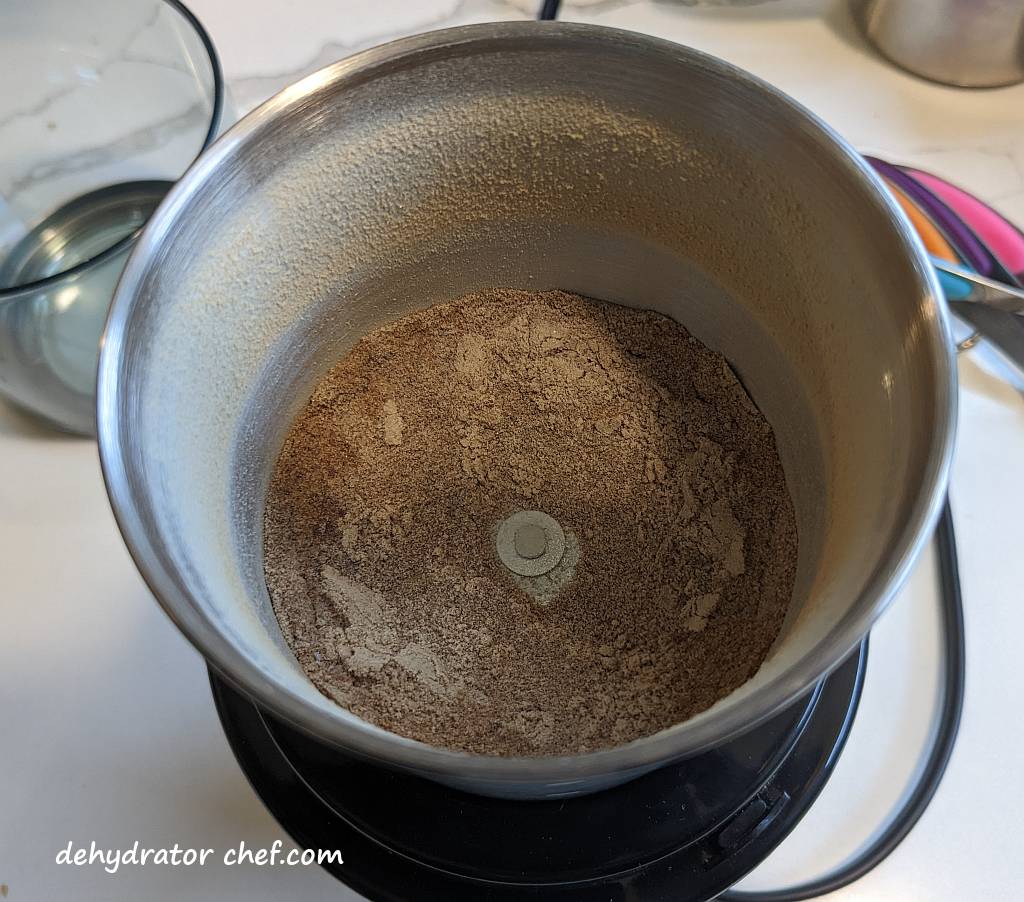
A standard canning jar funnel works great here as it fits inside the spice grinder bowl. Using a canning jar funnel makes it easier to get the shards of dehydrated beef stock into the spice grinder bowl.
For shorter-term storage of small batches of powdered beef stock, we use spice jars or canning jars if we have enough dehydrated beef stock. Since the canning jars are clear, it’s easy to see what’s inside.

We use these inexpensive food-safe desiccant packets which are available from Amazon. These 5-gram packets have over 5000 of mostly 4- and 5-star customer reviews, with an average of 4.7 stars out of 5. Our bag of 60 desiccant packets will last quite a while because they can be recharged and reused multiple times. Other food-safe sizes are available.

Do not leave your dehydrated food items exposed and unprotected any longer than necessary for the task at hand. It does not take long for dehydrated food items to naturally start hydrating from ambient household humidity. As such, this will increase the risk of mold growth.
With any of these storage methods, I’ll include a short note describing the contents and the date the product was dehydrated. The note also informs us where to go in the dehydrator logbook to make another note or two if needed.
Weights, Measures, and Serving Sizes
This information is from a recent entry from the notes we keep on most of our food dehydration efforts.
I started with 32 ounces / 1 quart of unsalted beef stock and 4 envelopes of Knox unflavored gelatin. Made the gelatin according to the directions on the box. When finished, I cut the gelatin into squares using a pastry dough scraper. A smaller stainless-steel spatula would probably work just as well.
Placed the beef stock gelatin squares on the dehydrator starting at 12:15 PM at 160 °F / 71 °C.
Checked to see how it was going at 2:30 PM. The gelatin had liquified and pooled across the fruit roll sheets. No spills or leaks, so I didn’t overfill them.
Checked again at 7:30 PM. Still mostly liquid. I am going to let the dehydrator run overnight.
Checked the trays at 6:30 AM. They are done.
The dehydrated and powdered beef stock weighed in at 40 grams by weight and measured 13 teaspoons by volume.
So, one cup of beef stock has dehydrated down to roughly 1 tablespoon by volume.
One teaspoon is 5 grams.
Insider Tips
Instead of adding only water to your dehydrated camping meals, you can now have a bullion for an instant stock and for more flavor.
Practice at home making dehydrated camping meals using the very same gear used in the field. We practice to reinforce the skills we have learned and to figure out what works for us and what doesn’t. Practice makes perfect.
